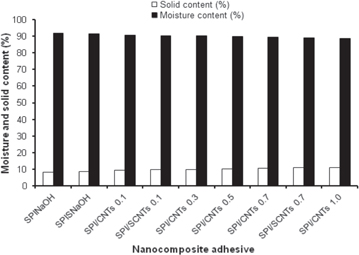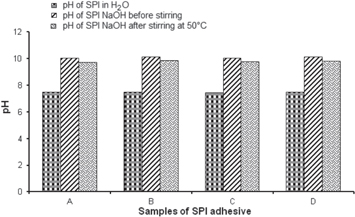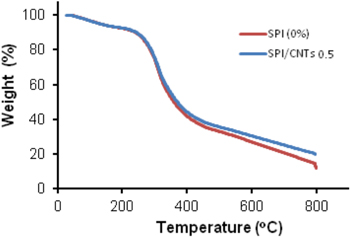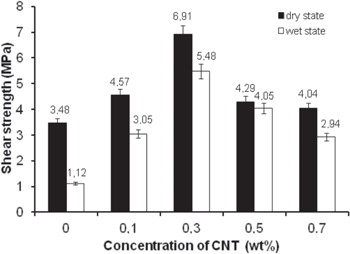Abstract
In this article the effect of dispersion method and carbon nanotubes (CNTs) loading on the quality and performance of a nanocomposite adhesive is reported. The nanocomposite soy protein isolate adhesive was successfully developed by incorporating CNTs into the soy protein isolate (SPI) for enhanced bond strength and water resistance. Dispersion methods, namely mechanical (shear) mixing and mechanical/sonication were employed to aid good dispersion and interfacial interaction between soy protein matrix and the carbon nanofillers during the preparation of the adhesive. The concentration of the CNT was varied from 0.1–0.7 wt% in the nanocomposite adhesive. The morphology and the surface chemistry of the adhesives were checked with SEM and FTIR, respectively. The shear strength of the developed adhesives was investigated according to European standard (EN-204) for interior wood application on a tensile testing machine. The morphological structure of the nanocomposite adhesive obtained from SEM images showed homogeneous dispersion of CNTs in SPI using the two dispersion methods; shear mixing and sonication/shear mixing. Fourier transform infrared spectra showed chemical functionalities and successful interaction between CNTs and SPI adhesive. Thermogravimetric profile of the adhesive samples showed that the newly developed nanocomposite adhesive was thermally stable at a temperature up to about 600 °C at a higher percentage loading of 0.5 wt% CNTs. The result showed that sonication method of dispersion of CNTs into the SPI adhesive had a higher shear strength compared to the mechanical method of dispersion both at dry and wet state.
Export citation and abstract BibTeX RIS

Original content from this work may be used under the terms of the Creative Commons Attribution 3.0 licence. Any further distribution of this work must maintain attribution to the author(s) and the title of the work, journal citation and DOI.
1. Introduction
Owing to the environmental threat formaldehyde- and petrochemical-based adhesive have caused to both users and workers [1], the development of environmental benign adhesives with enhanced shear strength and high water resistance has aroused the interest of many researchers. In addition, petrochemical-based adhesives are non-renewable, limited and costly [2]. Among other renewable resources, vegetable protein has been found to be the best applicable raw material for wood adhesive [3]. A soy protein-based adhesive, when modified chemically, is said to have the same good adhesive properties as petroleum-based and formaldehyde-based adhesives for interior wood products [2]. Furthermore, fillers are incorporated into the polymer to improve its properties, regulate the viscosity, modify the surface properties or simply reduce cost [4].
In recent years, nanosized fillers such as nanoparticles, nanotubes, nanoclay and nanofibers have been considered as fillers to replace the commonly used fillers like talc, calcium carbonate and wood dust. In addition, the commonly used fillers are often required in large percentage as filler [4]. However, nanofillers are required at lesser quantity and improve the properties of polymer adhesive at reduced concentrations [5]. Owing to the unique multifunctional properties, such as improved strength, unique structures, enhanced thermal conductivity, excellent electrical properties and thermal stability, carbon nanotubes (CNTs) have been considered an ideal candidate for as filler in composite materials [6–9]. Gojny et al [10] reported that incorporating CNTs into polymers enhanced the electrical and thermal conductivities of the polymers. Kwon et al [11] compared thermal conductivity of multi-walled carbon nanotubes (MWCNTs)/epoxy composites (with diglycidyl ether of bisphenol F (DGEBF)) and bisphenol A (DGEBA) (used as epoxy resins) and reported that thermal conductivity of MWCNTs/epoxy composite was higher than that of the pure epoxy resin. The enhanced thermal conductivity was attributed to the presence of CNTs in the epoxy resins. In addition, the thermal conductivity of the composite material could be enhanced if the CNTs are homogeneously dispersed within the epoxy. Many investigations have been carried out on the preparation of CNT/polymer composites for structural and functional applications [12–14]. Owing to the technical hitches associated with dispersion of entangled CNTs during processing and poor interfacial interaction between CNTs and polymer matrix, the complete potential of employing CNTs as filler has been strictly restricted.
Several dispersion techniques, such as, mechanical dispersion, optimum physical blending and chemical functionalization have been investigated to enhance the dispersion of CNTs in polymer matrices. Sandler et al [15] dispersed CNTs in epoxy under high speed stirring (2000 rpm) for 1 h, and reported that intense stirring was an effective process to achieve homogenous dispersion of the CNTs in the epoxy. Samal [16] synthesized an epoxy-based MWCNTs reinforced composite by method of sonication. The author reported that a small change in chemical treatment of the nanotubes has a great effect in the mechanical and morphological properties of nanocomposites due to effective load transfer mechanism and state of dispersion. Yu et al [6] employed a mechanical stirring with ultrasonication as a simple and operational approach to obtain the adhesives with rather homogeneously dispersed CNTs in the epoxy matrix. The results revealed that the thermal stability and electrical conductivity are improved with the addition of CNT and the adhesive thermal degradation temperature with 1 wt% of CNT was about 14 °C above that of control epoxy. Functionalization is another method of enhancing dispersion in polymer matrix [17]. Many investigations have been carried out to show the homogenous dispersion of CNTs in a polymer matrix. However, there are little literatures on the performance evaluation on effect of methods of dispersion on the tensile strength and water resistance of nanocomposite adhesive from soy protein isolate.
Therefore, in this article, as-synthesized CNTs were incorporated into soy protein isolate adhesive by shear mixing and sonication methods of dispersion to obtain homogeneous sample of CNTs/soy protein nanocomposite adhesive with improved tensile shear strength and enhanced water resistance.
2. Materials and methods
Commercial soy protein isolate (SPI) was purchased from Solae, LLC, and sodium hydroxide pellets were purchased from Sigma Aldrich. The original moisture and protein content of SPI were 5.5% and 90.0%, respectively. Carbon nanotubes were synthesized via carbon vapour deposition (CVD) technique using a horizontal CVD reactor as described elsewhere [18].
About 10.0 g of SPI was stirred in 90 mL distilled water at room temperature for 90 min The pH of the mixture was adjusted to 10.0 by adding 1.0 M of NaOH solution. The SPI-NaOH mixture was stirred for 1 h at 50 °C. The pH of the mixture was taken and recorded. 25 g of the mixture was placed in a petri dish and oven dried.
Varied amounts of CNTs and functionalized CNTs ranged from 0.1 to 0.7 wt% were dispersed in modified SPI adhesive by two different methods of dispersion. In the dispersion method 1, the alkali modified SPI/CNTs and SPI/FCNTs mixture was stirred on a magnetic stirrer at 1250 rpm for 2 h at room temperature. The pH values were taken and recorded. In the dispersion method 2, the alkali modified SPI/CNTs were sonicated in an ultrasound sonicator (UMC 20) for 90 min and stirred on magnetic stirrer for 30 min at 1250 rpm. The pH values of the SPI nanocomposite solution were taken and recorded. About 25 g of samples mixture of the SPI-NaOH and SPI nanocomposites was weighed before and after oven–drying in a petri dish for 3 h at 120 °C. The weight of the samples after drying was calculated and the percentage solid and moisture content were determined. The percentage solid content and the moisture content of the materials were determined using following formulae:

and

The morphology of the as-synthesized CNTs was checked using transmission electron microscopy (TEM) (FEI Tecnai T12) and scanning electron microscopy (SEM) (Carl Zeiss). The surface chemistry and the thermal stability of the oven dried samples were checked with Fourier transform infrared (FTIR) (Bruker Tensor 27) and thermogravimetric analysis (TA SDT Q600 Thermogravimetric analyzer), respectively. For TEM observation, the samples were sonicated in methanol for 5 min and later deposited on a holey carbon-coated TEM copper mesh grid. For the SEM, the CNTs samples were coated with 60% palladium and 40% gold (Pd/Au) prior to SEM analysis to prevent charge up. For the FTIR, the oven-dried powdered samples (2 mg) were mixed with 200 mg of potassium bromide (KBr) and pressed for 2 min at 200 MPa prior to the commencement of the scanning.
SPI nanocomposite adhesive was applied on the two ends of a wood surface (50 mm by 20 mm by 3 mm) with area of 20 × 15 mm2 and two other wood samples were joined to it. The wood composite was pressed at a pressure of 1.4 MPa and 120 °C for 10 min It was allowed to cool for 7 days. Performance evaluation of the adhesive strength on the wood was carried out on a tensile testing machine (AG-IC 20/50 KN Shimadzu) according to European standard EN-204. For dry test, after the wood composite has been allowed to dry for 7 days under ambient condition, tensile test was carried out on it and the results were recorded. Water soaking and drying (WSAD) test was carried out on some other samples. The bonded wood samples were immersed in water (23 °C) for 3 h and dried for 7 days under standard atmosphere, after that the bond strength test was carried out on them. Three wood composites were tested for each adhesive sample, and the average bond strength was calculated and recorded.
3. Results and discussion
Table 1 shows SPI NaOH-SPI adjusted to pH 10 with NaOH solution by high speed stirring, SPIS NaOH–stirring by sonication method/mixing, SPI (0.1–0.7)-SPI/CNTs with varying concentration from 0.1–0.7 wt% by high speed magnetic stirring and SPISCNTs 0.1- CNTs (0.1%) dispersed in SPI by sonication method/mixing. Figure 1 shows that the percentage solid content of the SPI adhesive increased by 10.6% when the pH was adjusted from 7.37 to 10.00. This observation indicates that increase in pH of SPI adhesive increases the percentage solid content and reduces the moisture content, because the higher the pH, the higher the hydrolysis [19]. As the concentration of the CNTs increased, the percentage solid content also increased. It shows that as the solid content of the SPI reduces, the moisture content increases accordingly.
Table 1. Solid and moisture contents of different adhesive nanocomposite samples at different values of pH.
| Adhesive nanocomposite samples | Solid content (%) | Moisture content (%) |
|---|---|---|
| SPINaOH | 7.96 | 92.04 |
| SPISNaOH | 8.4 | 91.6 |
| SPI/CNTs 0.1 | 9.48 | 90.52 |
| SPI/SCNTs 0.1 | 9.6 | 90.4 |
| SPI/CNTs 0.3 | 9.88 | 90.12 |
| SPI/CNTs 0.5 | 10.2 | 89.8 |
| SPI/CNTs 0.7 | 10.68 | 89.32 |
| SPI/SCNTs 0.7 | 10.76 | 89.24 |
| SPI/CNTs 1.0 | 11.12 | 88.88 |
Figure 1. Percentage solid and moisture contents of adhesive nanocomposite at varying concentrations.
Download figure:
Standard image High-resolution imageThe table 2 gives effect of temperature on pH of SPI adhesive. In figure 2, the pH values of the samples also dropped by 3.2%. The decrease in solid content could be attributed to the drop in pH values. When the pH of SPI adhesive was adjusted to 10 and then stirred at 50 °C for 1 h, the pH and the viscosity of the SPI solution decreased. The mean values of alkaline adjusted SPI adhesive before and after stirring were 10.06 and 9.47 respectively. This result indicates that temperature decreases the pH of the adhesive.
Table 2. Effect of temperature on pH of SPI adhesive.
| Sample | pH of SPI in H2O | pH of SPI NaOH before stirring | pH of SPI NaOH after stirring at 50 °C |
|---|---|---|---|
| A | 7.48 | 10.00 | 9.68 |
| B | 7.46 | 10.12 | 9.85 |
| C | 7.44 | 10.02 | 9.74 |
| D | 7.48 | 10.10 | 9.80 |
Figure 2. Effect of temperature on the SPI adhesive.
Download figure:
Standard image High-resolution imageFrom figure 3 it could be observed that SEM image of as-synthesized CNTs in figure 3(a) shows the aggregates of CNTs clustering together in bundles. Figure 3(b) shows the diameter of the CNTs. The average diameter of the CNTs is 47.57 nm.
Figure 3. SEM images of as-synthesized CNTs at (a) 1 μm and (b) 200 nm.
Download figure:
Standard image High-resolution imageFrom figure 4, surface morphology of the as-synthesized CNTs was presented. The images of the as-synthesized CNT sample show that there are impurities such as amorphous carbon, iron and cobalt particles. The presence of amorphous carbon impurities could be as a result of low pyrolysis temperature (700 °C) used in the synthesis of the CNTs, while the metal impurities (Fe and Co) are obtained from the excess metal catalyst particles that could not react during the synthesis of CNTs [18].
Figure 4. TEM images of as-synthesized CNTs at (a) 500 nm and (b) 1 μm.
Download figure:
Standard image High-resolution imageThe CNTs dispersed by mechanical method were quite evenly distributed in the SPI nanocomposite adhesive, only a few small aggregated bundles could be observed (figures 5(a) and (b)). Additionally, the CNTs were scattered randomly in the SPI matrix in all directions, providing the enhanced properties in all directions when dispersed by sonication/mechanical method for 120 min (figures 5(c) and (d)). There were no much apparent aggregations and damage of the nanotubes in the nanocomposite adhesives, suggesting the effectiveness of procedures and parameters used to disperse the CNTs into the SPI [6]. In high speed mixing, it was noticed that bubbles were generated which was difficult to remove. Nevertheless, the two methods have proven to be suitable for dispersion of CNTs in SPI adhesive [20].
Figure 5. SEM images 0.1 wt% CNTs dispersed in SPI adhesive nanocomposites by mechanical mixing method (a) and (b), and by sonication and 30 min mechanical mixing in SPI nanocomposite adhesive (c) and (d).
Download figure:
Standard image High-resolution imageAccording to the FTIR spectra of bands of the SPI/CNTs nanocomposite samples in figure 6(a), amide band I is the most susceptible to changes in the secondary structure of protein. This was found to be around spectra band of 1637 cm−1–1664 cm−1 in all the SPI/CNTs nanocomposite adhesive samples, which is related to C=O stretching. This can be attributed to the pH adjustment of adhesive samples to 10 [21, 22]. Amidic band II which is related to N-H bending is located around 1535 cm−1–1558 cm−1 in all the samples. Amide band III which is C-N and N-H stretching is located around 1245 cm−1. The band in all the SPI/CNTs nanocomposite adhesive samples around 3249 cm−1–3328 cm−1 (figure 6(a)) is related to O-H functional group which is attributed to the availability of amidic band due to unfolding of protein by adjustment of adhesive pH [21]. The FTIR spectrum of as-synthesized CNTs is presented in figure 6(b), as observed, the CNTs show a peak at 1527 cm−1 which is assigned to the C-C bond. The weak peak at approximately 1720 cm−1 is attributed to the C=O bonds (figure 6(b)) [23]. These results show effective interaction between SPI adhesive and CNTs which contributed to improved bond strength.
Figure 6. FTIR spectra of (a) pure SPI, adhesive soy/CNTs, SPI/SCNTs nanocomposite adhesive and (b) as-synthesized CNTs.
Download figure:
Standard image High-resolution imageThe TGA profiles of pure SPI adhesive and 0.5 wt% SPI/CNTs are depicted in figure 7. The TGA determines the derivative weight change and percentage weight as a function of temperature. This analysis was carried out to determine the thermal stability of the adhesive samples. This result indicates that pure SPI adhesive and adhesive nanocomposite with 0.5 wt% of CNTs underwent two stages of weight loss from 23 °C to 800 °C. The first weight loss occurred between 23 °C and 200 °C, which may be attributed to the lower molecular weight of material. The weight loss for the second stage occurred between temperature of 319 °C and 387 °C, which is attributed to the thermal degradation of soy protein isolate at higher molecular weight formed after oven-curing of the adhesive [6]. The TGA profile also shows that SPI/CNTs 0.5 had weight loss of 80% at 800 °C while pure SPI without CNTs had over 80% weight loss. This result is an indication that presence of CNTs reduces the thermal degradation of the nanocomposite adhesive.
Figure 7. TGA profile of the SPI (0 wt% CNT) adhesive and SPI/CNTs (0.5 wt% CNT) adhesive nanocomposites.
Download figure:
Standard image High-resolution imageFrom the data in figure 8, alkaline modified adhesive with 0 wt% loading of CNTs had higher shear strength (3.38 MPa) against 1.0 MPa which was the minimum for pure soy protein adhesive for interior wood application according to the JISK6806-2003 standard [19]. This could be attributed to the unfolding of protein structure by NaOH. This enabled the amino acid buried inside to be made available during curing, thus, enhancing the penetration and adhesion of SPI without CNTs as well as SPI/CNTs nanocomposite adhesive [24]. The shear bond strength increases through 0.3wt % (6.91 MPa) and started decreasing at 0.5 wt% CNTs [25]. There are obvious differences in the shear bond strength of the adhesive samples with and without the incorporation of carbon nanotubes. It was observed in figure 8 that the shear strength of adhesive with 0 wt% loading fraction of CNTs (3.48 MPa) was lower than the nanocomposite adhesive with 0.7 wt% CNTs (4.04 MPa and 2.94 MPa) at dry and wet state respectively. This may be attributed to the properties of the CNTs transferred into the SPI adhesive during dispersion.
Figure 8. Effect of CNT loading on the shear strength of SPI adhesive. The data are the mean values of 3 replicates and the error bar represents 0.5 standard deviation.
Download figure:
Standard image High-resolution imageFigure 9 shows the effect of methods of dispersion on the shear strength of the SPI nanocomposite adhesive. Two different methods of dispersion of 0.7 wt% loading of CNTs were investigated on their effect on the shear strength and water resistance of the nanocomposite adhesive. It could be observed that the shear bond strength of adhesive (SPI/SCNTs 0.7) dispersed by method of sonication had shear strength of 4.40 MPa, which is around 10% higher than the shear bond strength of adhesive (SPI/CNTs 0.7) dispersed by shear mixing with shear strength of 4.04 MPa. This indicates that the ultrasound energy in the sonicator mixing generated a vibration which resulted into better dispersion of the CNTs in the SPI adhesive. Adhesives with 0.7 wt% loading fraction of CNTs for both sonication and shear mixing methods had higher shear strengths than that of pure SPI adhesive without CNTs. The results show that the shear strength of nanocomposite adhesive with 0.3 wt% loading fraction of CNTs was over 100% higher than the shear strength of pure alkaline modified SPI adhesive without reinforcement at both dry and wet states.
Figure 9. Effect of methods of dispersion on the shear strength of the nanocomposite adhesive. The data are the mean values of 3 replicates and the error bar represents 0.5 standard deviation. Pure SPI is alkaline modified SPI with 0 wt% CNTs; SPI/CNTs0.7 is 0.7 wt% CNTs dispersed by method of mechanical mixing in SPI; and SPI/SCNTs0.7 is 0.7 wt% of CNTs dispersed by method of 90 min sonication and 30 min mechanical mixing in SPI.
Download figure:
Standard image High-resolution imageTable 3 shows the comparison of shear strength of soy protein adhesive from literatures with results of this study. Information from the table shows that the incorporation of other fillers into soy-based adhesives improved the shear strength, although at higher percentage loading. However, CNTs as reinforcement used in this study, improve the shear strength of adhesive at a reduced percentage loading compared to other modifiers. This table also shows that incorporation of CNTs improved the shear strength and water resistance of soy protein based adhesive by sonication method of dispersion of CNTs into the soy protein matrix.
Table 3. Comparison of parameters of different composites.
| Modifier/Filler | Polymer matrix | Dispersion methods | Concentration of modifier (%) | Shear strength at dry state (MPa) | Shear strength at wet state (MPa) | Reference |
|---|---|---|---|---|---|---|
| CaCl2+ NaOH | DSF | mechanical | — | 0.85 | 0.64 | [1] |
| PI | SBP | sonication | 0.49 | 2.53 | _ | [19] |
| MMT | SBP | sonication | 3 | 3.06 | 0.64 | [19] |
| PEI +MA | SF | mechanical | 1.32 | improved | improved | [24] |
| CaCO3 | SP | mechanical | 10 | 5 | 5 | [2] |
| CNTs | SPI | mechanical | 0.7 | 4.04 | 2.94 | This study |
| CNTs | SPI | sonication | 0.7 | 4.40 | 3.90 | This study |
MMT- montmorrilonite, PEI+MA- polyethylenimine/maleic anhydride, SBP- soy bean protein, SF- soy flour, SP- soy protein, PI-polyisocyanate, DSF- defatted soy flour. The data are the mean values of 3 replicates and the error bar represents 0.5 standard deviation.
4. Conclusion
A well CNT-dispersed adhesive was prepared successfully by use of two different dispersion methods; shear mixing and ultrasonication with 30 min of shear mixing. With sonication/shear mixing method of dispersion, the carbon nanotubes were distributed uniformly in the soy protein adhesive with no noticeable clusters at relatively reduced fractions of CNTs as shown in the SEM images. However, for shear mixing methods of dispersion, agglomerates of CNTs could still be observed. Thermogravimetric analysis of the sample also showed that the CNTs incorporation increased the thermal stability of the nanocomposite adhesive compared to SPI adhesive without CNTs. The FTIR spectra showed the surface functionalities of the nanocomposite SPI adhesive and the successful interaction of the CNTs with the SPI adhesive matrix, which contributed to the effective dispersion of the CNTs in the nanocomposite adhesive. Dispersion of CNTs into the SPI by sonication/mechanical mixing displayed a higher shear strength and water resistance compared to using mechanical shear mixing as a method of dispersion. The result shows that mechanical/sonication method of dispersion is an effective method of dispersion of CNTs into soy protein adhesive. Therefore, incorporation of CNTs as reinforcement into a renewable soy protein-based adhesive via mechanical/sonication dispersion method has produced a new adhesive which could replace formaldehyde and petrochemical adhesive in the market and be of useful application in the industry with improved shear strength and water resistance.










